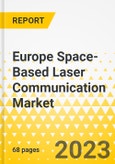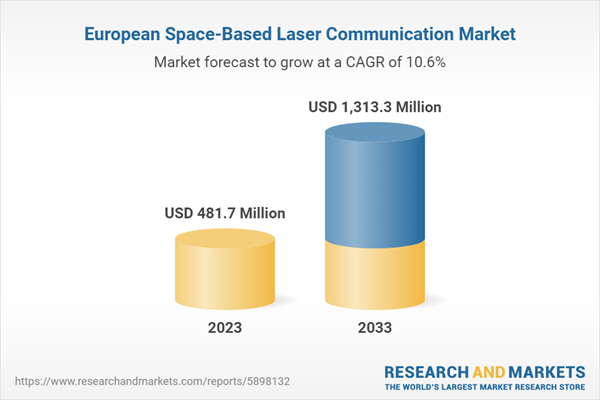artificial intelligence (AI), electronically steered antennas (ESAs), component miniaturization, and ISLs, are primarily driving growth in this market
This report comes with 10% free customization, enabling you to add data that meets your specific business needs.
Europe is one of the prominent regions for the growth of the space-based laser communication market. A consortium of prominent European space and telecommunications companies, comprising Airbus Defense and Space, Eutelsat, SES, and Thales Alenia Space, has joined forces to submit a bid for a proposed satellite constellation that aims to rival SpaceX's Starlink system. With the European Union (EU) taking the lead, the project will receive a substantial funding commitment of $2.64 billion in 2023. Additionally, the project is expected to secure further financial support from the European Space Agency and private investments, bolstering its overall funding capacity.
Market Introduction
The introduction of second-generation satellites with intersatellite links (ISL) has resulted in a notable increase in the market for space-based laser communication in Europe. Modern technologies that improve communication performance both on Earth and in space, such as artificial intelligence (AI), electronically steered antennas (ESAs), component miniaturization, and ISLs, are primarily driving this rise.Prominent firms that are creating massive constellations in low Earth orbit (LEO) and medium Earth orbit (MEO), such OneWeb, SpaceX, and Amazon's Project Kuiper, also have an impact on the market's trajectory. 2023 will see the integration of laser terminals by low Earth orbit satellites, such those operated by Starlink, into a constellation with optical intersatellite connections (OISLs), producing a strong mesh network in orbit. When it is fully deployed, Telesat's LightSpeed constellation also intends to include optical satellite links, while OneWeb is considering include optical links in its second phase of rollout. Inter-satellite links are made easier by the inherent nature of Amazon's Kuiper constellation.
To bring cutting-edge and novel products, major participants in this industry, such as Tesat-Spacecom GmbH & Co., SKYLOOM, Bridgecomm, and Mynaric, are substantially investing in research and development.
Market Segmentation:
Segmentation 1: by End User
- Government and Military
- Commercial
Segmentation 2: by Solution
- Space-to-Space
- Space-to-Other Application
- Space-to-Ground Station
Segmentation 3: by Region
- Europe - U.K., France, Germany, Russia, and Rest-of-Europe
How this Report Can Add Value
Product/Innovation Strategy: The product segment helps the reader understand the different types of components available for deployment and their potential globally. Moreover, the study provides the reader with a detailed understanding of the europe space-based laser communication market by end user and solution.Growth/Marketing Strategy: The europe space-based laser communication market has seen major development by key players operating in the market, such as contract, collaboration, and joint venture. The favored strategy for the companies has been contracts to strengthen their position in the europe space-based laser communication market.
Competitive Strategy: Key players in the europe space-based laser communication market analyzed and profiled in the study involve major europe space-based laser communication companies providing components. Moreover, a detailed market share analysis of the players operating in the europe space-based laser communication market has been done to help the reader understand how players stack against each other, presenting a clear market landscape. Additionally, comprehensive competitive strategies such as partnerships, agreements, and collaborations will aid the reader in understanding the untapped revenue pockets in the market.
Methodology: The research methodology design adopted for this specific study includes a mix of data collected from primary and secondary data sources. Both primary resources (key players, market leaders, and in-house experts) and secondary research (a host of paid and unpaid databases), along with analytical tools, are employed to build the predictive and forecast models.
Data and validation have been taken into consideration from both primary sources as well as secondary sources.
This product will be delivered within 3-5 business days.
Table of Contents
Executive Summary
The Europe space-based laser communication market is estimated to reach $ 1.31 billion in 2033, reveals the premium market intelligence study. The study also highlights that the market is set to witness a CAGR of 10.55% during the forecast period 2023-2033.Europe is estimated to account for a share of 32.1% of the space-based laser communication market in 2023. Europe is one of the prominent regions for the growth of the space-based laser communication market.
The Europe Space-Based Laser Communication Market: Driver and Challenges
The Europe space-based laser communication market is experiencing notable growth due to substantial investments and a dedicated emphasis on research and development aimed at introducing innovative and cutting-edge solutions.The ESA, as a leading space organization in Europe, places a strong emphasis on ensuring the highest quality standards for space-related products and technologies. While this commitment to quality is crucial for the success and reliability of space missions, it can also present challenges for smaller companies and startups that may find it difficult to meet these rigorous standards.
USPs of report
- A qualitative and quantitative analysis of the europe space-based laser communication market based on application and product, such as by component and range
- Quantitative analysis
- A detailed company profile comprising established players and some start-ups that are capable of significant growth with an analyst view
Analyst’s Perspective on Europe Space-Based Laser Communication Market
The Principal Analyst states, 'The space-based laser communication market represents a transformative frontier in the satellite communication industry, poised to revolutionize global connectivity. With the ever-increasing demand for high-speed data transmission, space-based laser communication offers a paradigm shift from traditional radio frequency systems. The convergence of various factors such as decreasing launch costs, advancements in laser technology, and the insatiable appetite for bandwidth-intensive applications such as 5G, IoT, and Earth observation, are propelling this market. Moreover, space-based laser communication promises lower latency, higher data rates, and enhanced security compared to its RF counterparts, opening up possibilities for not only the commercial satellite market but also defense and scientific missions. However, it is essential to acknowledge the inherent challenges, including atmospheric interference, beam divergence, and optical component reliability in the unforgiving space environment, that must be overcome for widespread adoption. The competitive landscape is dynamic, featuring both established aerospace giants and innovative start-ups vying for supremacy in this burgeoning sector. Government support, international collaboration, and regulatory frameworks will significantly influence market dynamics. Moreover, the space-based laser communication market is at a critical juncture, with immense growth potential contingent on technological breakthroughs and strategic partnerships, promising a future where the cosmos becomes the backbone of global connectivity.'Key Questions Answered in the Report
- How is the europe space-based laser communication market expected to grow during the forecast period 2023-2033?
- What are the opportunities for companies to expand their businesses in the europe space-based laser communication market?
- What are the key developmental strategies implemented by the key players to sustain in this highly competitive market?
- What is the current and future revenue scenario of the europe space-based laser communicationmarket?
Companies Mentioned
- HENSOLDT
- Mynaric
- ODYSSEUS SPACE SA
- Tesat-Spacecom GmbH & Co.
- Thales Alenia Space
Table Information
| Report Attribute | Details |
|---|---|
| No. of Pages | 68 |
| Published | November 2023 |
| Forecast Period | 2023 - 2033 |
| Estimated Market Value ( USD | $ 481.7 Million |
| Forecasted Market Value ( USD | $ 1313.3 Million |
| Compound Annual Growth Rate | 10.5% |
| Regions Covered | Europe |
| No. of Companies Mentioned | 5 |









